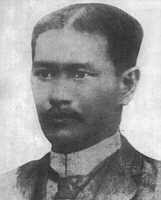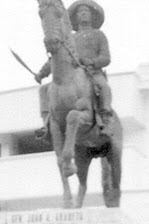A TALE OF FILIPINO BLOOD BROTHERS
(By: dinggol araneta divinagracia - January 15, 2018)
The Batangueños, the Ilonggos and the Tausogs of Sulu Bloodline.
There are many similarities in the inherent traits and characterestics of the Batangueños, the Ilonggos and the Tausogs of Sulu. These three ethnic groups; natives of Luzon, Visayas and Mindanao respectively, are skilled in making distinctive bladed weapons. The Batangueños for balisong, bente nueve and malapad; the Ilonggos for talibong, ginunting and pinuti and the Tausogs for kalis, kris, barong and kampilan. Common among the three is the sundang, punyal or dagger.
They are believed to be trustworthy, loyal to their kind, noted poets and speak with soft romantic intonation; but fierce and dangerous when provoked.
Many are ambulant peddlers of woven textile products; such as habol (blanket), patadyong (sarong) and moskitero (mosquito net). These are made of abaca, buri, cotton, jusi, nipa, and piña that are abundant in their locality.
Only in these three ethnic groups, we learned that in defending their honor and patrimony have gone "Huramentado", berseck or run amuck and charged fearlessly, often with sharp bladed weapons on hand, that instilled fear in the heart and demoralized their adversaries.
The reason could be traced to the genealogical and early history of their forebears, thus:
The Maragtas legend explained and the ancient Chinese Ming dynasty chronicle confirmed; that sometime during the 13th century, ten (10) Shri-Vishayan datus together with their families, households and subordinates fled Bornay (Borneo) in search of a new life. Led by the Sultanate Minister Datu Putih, they sailed their "Balanghais" unto uncertain fate and landed in Siruanga/Sirawagan (San Joaquin-Iloilo) in the island of Aninipay (Panay).
They bartered their gold and jewelries with the local "Ati" Chieftain Marikudo for the lowlands, plains and valleys of the island they called Madya-as or paradise. The land where time began the birth of the "Ilonggo Nation" and the cradle of an ancient Filipino civilization.
After partitioning Madya-as into Akean (Aklan & Capiz), Irong-irong (Iloilo) and Hamtik (Antique) to be ruled by Datu Bangkaya, Paiburong and Sumakwel respectively; Datu Putih and the other tribal leaders settled along the banks of the river by the sea with rich, fertile soil and abundant marine products. These noble-bearing Malays then called their settlement facing Himal-os or Guimaras --"Araut" (Dumangas).
Thereafter, the Council of Elders established the "Katiringban et Madya-as" or the Confederation of Madya-as headed by Datu Sumakwel, who later on codified his Maragtas Code and the Code of Kalantiao. The 'Katiringban et Madya-as" confederated form of governance preceded great nations in Europe and the Americas.
Our national Hero, the pride of the Malayan race, Dr. Jose Rizal, stated in his essay about this early Malay settlement of our adventurous sea-faring forefathers in Dumangas, Iloilo.
Excerpted from Jose Rizal's essay "The Indolence of the Filipinos" originally written in Spanish and published in La Solidaridad on September 15, 1890 (English translation by Charles Derbyshire)
Part Three"...Wherefore, Gaspar de San Agustin O.S.A says:
"Although anciently there were in this town of 'Dumangas' many people, in the course of time they have very greatly diminished because the natives are the best sailors and most skillful rowers on the whole coast, and so the governors in the port of Iloilo take most of the people from this town for the ships that they send abroad..."
Years later, Datu Putih and two other tribal leaders together with some of their tribesmen decided to leave Araut and go farther north towards "Selorang Lusong" passing the Island of Mindoro until they reached the mouth of Taal (Batangas) river and there, set up the first Malay settlement in Luzon that eventually spread along the coastal areas in Batangas.
In the year 1570, Kapitan Juan de Salcedo, grandson of the "El Adelantado" Miguel Lopez de Lagaspi --as second in command to Spanish conquistador Martin de Goiti, together... explored the coast of Batangas on their way to "Maynilad" and came upon this existing ancient Malay settlement. Two years later, the town of Taal in Batangas was founded.
Undoubtedly, before Datu Putih and his group went back to Bornay (Borneo), their seeds were planted along the banks of Araut (Dumangas) River in Iloilo; Taal River and the coastal areas of (Batangas) in Southern Luzon and the most logical route back to Bornay; via the Tausog Region where early Malay settlements were established in the Sulu archipelago in Mindanao.
Therefore, the Batangueños, the Ilonggos and the Tausogs of Sulu, even perhaps, those from Mindoro have direct bloodline from Datu Putih and his Malay group from Bornay. And that was long before the Spaniards began the rampage to colonize the "Islas" with the bible, the cross and the sword in the name of their God and their King. ~~~
(By: dinggol araneta divinagracia - January 15, 2018)
The Batangueños, the Ilonggos and the Tausogs of Sulu Bloodline.
There are many similarities in the inherent traits and characterestics of the Batangueños, the Ilonggos and the Tausogs of Sulu. These three ethnic groups; natives of Luzon, Visayas and Mindanao respectively, are skilled in making distinctive bladed weapons. The Batangueños for balisong, bente nueve and malapad; the Ilonggos for talibong, ginunting and pinuti and the Tausogs for kalis, kris, barong and kampilan. Common among the three is the sundang, punyal or dagger.
They are believed to be trustworthy, loyal to their kind, noted poets and speak with soft romantic intonation; but fierce and dangerous when provoked.
Many are ambulant peddlers of woven textile products; such as habol (blanket), patadyong (sarong) and moskitero (mosquito net). These are made of abaca, buri, cotton, jusi, nipa, and piña that are abundant in their locality.
Only in these three ethnic groups, we learned that in defending their honor and patrimony have gone "Huramentado", berseck or run amuck and charged fearlessly, often with sharp bladed weapons on hand, that instilled fear in the heart and demoralized their adversaries.
The reason could be traced to the genealogical and early history of their forebears, thus:
The Maragtas legend explained and the ancient Chinese Ming dynasty chronicle confirmed; that sometime during the 13th century, ten (10) Shri-Vishayan datus together with their families, households and subordinates fled Bornay (Borneo) in search of a new life. Led by the Sultanate Minister Datu Putih, they sailed their "Balanghais" unto uncertain fate and landed in Siruanga/Sirawagan (San Joaquin-Iloilo) in the island of Aninipay (Panay).
They bartered their gold and jewelries with the local "Ati" Chieftain Marikudo for the lowlands, plains and valleys of the island they called Madya-as or paradise. The land where time began the birth of the "Ilonggo Nation" and the cradle of an ancient Filipino civilization.
After partitioning Madya-as into Akean (Aklan & Capiz), Irong-irong (Iloilo) and Hamtik (Antique) to be ruled by Datu Bangkaya, Paiburong and Sumakwel respectively; Datu Putih and the other tribal leaders settled along the banks of the river by the sea with rich, fertile soil and abundant marine products. These noble-bearing Malays then called their settlement facing Himal-os or Guimaras --"Araut" (Dumangas).
Thereafter, the Council of Elders established the "Katiringban et Madya-as" or the Confederation of Madya-as headed by Datu Sumakwel, who later on codified his Maragtas Code and the Code of Kalantiao. The 'Katiringban et Madya-as" confederated form of governance preceded great nations in Europe and the Americas.
Our national Hero, the pride of the Malayan race, Dr. Jose Rizal, stated in his essay about this early Malay settlement of our adventurous sea-faring forefathers in Dumangas, Iloilo.
Excerpted from Jose Rizal's essay "The Indolence of the Filipinos" originally written in Spanish and published in La Solidaridad on September 15, 1890 (English translation by Charles Derbyshire)
Part Three"...Wherefore, Gaspar de San Agustin O.S.A says:
"Although anciently there were in this town of 'Dumangas' many people, in the course of time they have very greatly diminished because the natives are the best sailors and most skillful rowers on the whole coast, and so the governors in the port of Iloilo take most of the people from this town for the ships that they send abroad..."
Years later, Datu Putih and two other tribal leaders together with some of their tribesmen decided to leave Araut and go farther north towards "Selorang Lusong" passing the Island of Mindoro until they reached the mouth of Taal (Batangas) river and there, set up the first Malay settlement in Luzon that eventually spread along the coastal areas in Batangas.
In the year 1570, Kapitan Juan de Salcedo, grandson of the "El Adelantado" Miguel Lopez de Lagaspi --as second in command to Spanish conquistador Martin de Goiti, together... explored the coast of Batangas on their way to "Maynilad" and came upon this existing ancient Malay settlement. Two years later, the town of Taal in Batangas was founded.
Undoubtedly, before Datu Putih and his group went back to Bornay (Borneo), their seeds were planted along the banks of Araut (Dumangas) River in Iloilo; Taal River and the coastal areas of (Batangas) in Southern Luzon and the most logical route back to Bornay; via the Tausog Region where early Malay settlements were established in the Sulu archipelago in Mindanao.
Therefore, the Batangueños, the Ilonggos and the Tausogs of Sulu, even perhaps, those from Mindoro have direct bloodline from Datu Putih and his Malay group from Bornay. And that was long before the Spaniards began the rampage to colonize the "Islas" with the bible, the cross and the sword in the name of their God and their King. ~~~























No comments:
Post a Comment